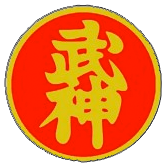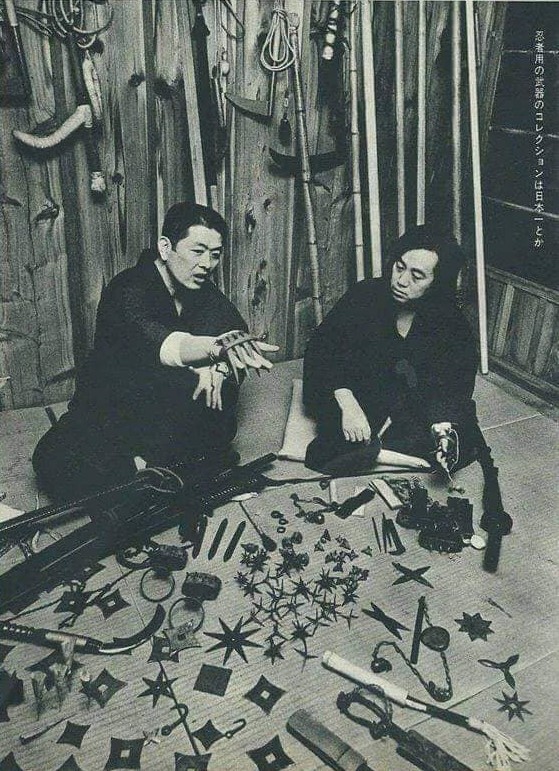Bujinkan – Information
BUJINKAN DOJO
‘The place where the Divine Warrior practices’

Bujinkan (武神 館) or Bujinkan Budo Taijutsu is a Japanese martial art based in Nodashi, Chiba-ken, Japan.
Founded by Masaaki Hatsumi (1931).
In 1972, after receiving the title of Soke (宗家, ‘head of the family’) from Takamatsu Sensei, the bearer of all knowledge (Menkyo Kaiden), he united all the transferred skills and founded Bujinkan, meaning ‘Divine Warrior’. He named it after Takamatsu Sensei, his teacher, who was the first person to be given the title of Soke in the nine Ryu (schools) that make up the Bujinkan and whose history stretches back to the ninth century, for the goal of developing Ninjutsu art and unifying nine old warrior traditions.
All nine schools or traditions (ryu) are represented, as well as three schools of Ninjutsu, three Samurai, and three who practiced both Ninja and Samurai. The teachings of these schools were passed down through the lineage of two hundred and one Soke and thousands of warriors under their guidance in direct teacher/student relations.
Grading system and ranking:
Three bands make up the Bujinkan rank structure: white, green / red, and black. The white belt, known as ‘Mukyu,’ is worn by new members of the dojo (no rank). After certification by his or her instructors, the disciple begins as a mukyu (literally meaning ‘without kyu,’ i.e. 10th kyu) and progressively progresses to ‘Ichikyu’ (1st kyu) and finally to Shodan.
Green belts are worn by junior dojo members (Kukyu – Ikkyu, 9th rank – 1st rank). Instead of a green belt, female club members (Kunoichi) wear a red belt.
Members of the Bujinkan traditionally wear wappan (emblem), hoshi (stars), and obi (belt) with their gi (traditional black training clothing, also referred to as kimono in the West), which differ to denote rank.
Wappan is a round patch (emblem) that is worn on the gi on the left side of the chest above the heart and has the Kanji translation of Bujin in the center. Wappan is comes in three color combinations that distinguish kyu, day, and higher day rank.
The kanji ‘bu’ (武) and ‘jin’ (神) are used to write Wappen (ワ ッ ペ ン).
Color is used to highlight the levels.

There are five different types of emblems (9 to 1 kyū, 1 to 4 day, 5 to 9 day, and 10 to 15 day), with Dai Shihan being the most recent. Purple indicates the heart’s purest state. The sun, which brings life to the world, is represented by the orange outline.
Shihan (師範) is a Japanese term used as an honorific title for professionals or senior instructors in various Japanese martial arts. It means ‘master instructor’ in English.

Dr. Hatsumi has his own wappan color (emblem), which distinguishes him as the international Bujinkan Dojo’s Soke (head of the family).

There are 5 honorary ranks that can only be obtained from Hatumi Sensei after reaching Judan (10th level black belt). These levels are also directly related to the theme of the five elements;
- dan – Chi (Earth) 1 golden star
- dan – Sui (Water) 2 golden stars
- dan – Ka (Fire) 3 golden stars
- dan – Fu (Wind) 4 golden stars
- dan – Ku (Emptiness) or the ethereal 5 golden stars
Togakure-ryu origins (schools):
- Daisuke Togakure (1162.)
- Shima Kosanta Minamoto no Kanesada (1180.)
- Goro Togakure (1200)
- Kosanta Togakure
- Kisanta Koga
- Tomoharu Kaneko
- Ryuho Togakure
- Gakuun Togakure
- Koseki Kido
- Tenryu Iga
- Rihei Ueno
- Senri Ueno
- Majiro Ueno
- Saburo Iisuka
- Goro Sawada
- Ippei Ozaru
- Hachiro Kimata
- Heizaemon Kataoka
- Ugenta Mori
- Gobei Toda
- Seiun Kobe
- Kobei Momochi
- Tenzen Tobari
- Seiryu Nobutsuna Toda (1624.-1658.)
- Fudo Nobuchika Toda (1658.-1681.)
- Kangoro Nobuyasu Toda (1681.-1704.)
- Eisaburo Nobumasa Toda (1704.-1711.)
- Shinbei Masachika Toda (1711.-1736.)
- Shingoro Masayoshi Toda (1736.-1764.)
- Daigoro Chikahide Toda (1764.-1804.)
- Daisaburo Chikashige Toda (1804.)
- Shinryuken Masamitsu Toda (born 1824. – died 1909.)
- Toshitsugu Takamatsu (born 1887. – died 1972.)
- Masaaki Hatsumi (born 1931. – )
BUJINKAN RYU (schools):
- Togakure Ryu Ninpo Taijutsu | Hidden Door School 1161 | Togakure-ryu Ninjutsu
- Gyokko Ryu Kosshijutsu | Jewel Tiger School 1156 | Gyokko-ryu Bone Finger Art
- Kukishinden Ryu Happo Bikenjutsu | School of nine demons 1336 |
- Koto Ryu Koppojutsu | Tiger shooting school 1532 |
- Shinden Fudo Ryu Dakentaijutsu | The school of the immobile heart 1113 | Shinden Fudo Ryuuchi Fudojutsu
- Takagi Yoshin Ryu Jutaijutsu | Tall tree, school of the raised heart 1625 |
- Gikan Ryu Koppojutsu | The school of truth, loyalty and justice 1558 |
- Gyokushin Ninpo Taijutsu | School with jewels of the heart 1532 |
- Kumogakure Ryu Ninpo Taijutsu | School of hiding in the clouds 1532 |

The traditional Ninja had to master and be perfect in 18 basic categories of martial arts called Bugei Juhappan. Some of these warrior skills are still taught at the Bujinkan Dojo.
- Seishin Tekky Kyoyo – spiritual and mental improvement
- Taijutsu – bare-handed combat skills that include techniques and Taihenjutsua, Dakentaijutsua, Koppojutsua and Koshijutsua skills
- Ken jutsu / Biken jutsu – the skill of using the Samurai saber – Daisho, Ninja To –Ninja Sword, Tanto, Kodachi, etc.
- Bo jutsu – skill that includes using different types of sticks and poles
- Shuriken jutsu – blade throwing skill
- So jutsu – skill that includes using and combat techniques of the spear
- Naginata jutsu – skill of using and fighting techniques Japanese halberd
- Kusarigama – the skill of using weapons with blades and with a chain
- Kayaku jutsu – skills in the use of firearms and tools, fire and explosives
- Henso jutsu – disguise and imitation skills
- Shinobi Iri – skills of secret movement, invisibility and ways of entering
- Ba jutsu – riding skills and horsemanship
- Sui ren – water fighting skills: water movements and diving
- Bo ryaku – strategy and tactics of struggle in urban areas and open spaces
- Cho Ho – espionage
- Inton jutsu – the skill of concealment, avoidance, and camouflage, the use of Goton po
- Chi Mon – geography
- Ten mon – meteorology
Guidelines for participation in Bujinkan
- Bujinkan will only be open to individuals who agree to and follow the Bujinkan Dojo’s rules. Those who do not comply will be denied entry. Only those who have read and agreed to the following guidelines will be permitted to join.
- Only those with actual patience, self-control, and determination will be permitted to take part. It is necessary to obtain a medical examination report. People with mental disease, drug addiction, or mental instability, in particular, will be prevented from participating. Individuals who may constitute a threat to others, such as those with infectious diseases or illnesses, people with mental or physical impairments, and people who lack self-control, are required to file such a report.
- People with a criminal record will be turned down. Those who cause issues, have committed a crime, or who live in Japan and break domestic laws will not be permitted entry.
- Those who violate the Bujinkan’s rules, whether as members of the club or as members of society, by engaging in disgraceful or disgusting behavior, will be expelled. Bujinkan has previously welcomed a huge number of visitors to Japan. Sadly, people who performed violent acts while inebriated, the mentally ill, and those who cause issues by thinking only on themselves and not realizing how their actions could harm others were among them. With their conduct, such people disregarded the Bujinkan’s traditional, righteous heart. All of these folks will be expelled starting today.
- Accidents that occur during training (both inside and outside the dojo) should not be a source of concern for the Bujinkan. This is a crucial factor to remember. Those who refuse to assume personal responsibility for any mishaps that occur during the Bujinkan training will be rejected. To be clear, Bujinkan will not be held liable for any injuries sustained while training, regardless of location.
- Everyone who joins the Bujinkan is required to obtain an annual membership card. This card not only maintains respect among Bujinkan members, but it also shows that you are a part of a larger whole – those whose members come together with the heart of a warrior to improve themselves through training and companionship. It extols the virtues of the warrior and epitomizes loyalty and brotherly love.
- The Bujinkan tradition recognizes the universality and nature of all human existence, as well as the natural flow between the two:
-
-
- ‘The secret principle of Taijutsu is to know the foundation of peace.
- Learning is the way to an unwavering heart (fudoshin). ‘
-
Bujinkan has recently become truly international. There are distinct taboos among the peoples and nations of the world, just as there are different time zones. We must treat one other with respect and endeavor to avoid such taboos. We must prioritize the warrior’s heart while working together to enhance Bujinkan.
Those who do not follow the aforementioned rules will be expelled from Bujinkan.
Masaaki Hatsumi – Soke
